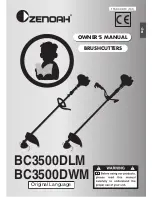
2
• Place the tool horizontally on a substantial work
surface. The work surface must have a rated weight
capacity that exceeds the weight of the cutter and of
the material being cut.
• Fragments and splinters may be ejected from the
cutter during normal use. The end of the material
being cut may become a projectile as it separates
during cutting. Stay clear of the cutting head and
surrounding area during operation. Always wear face
and eye protection.
• As needed, remove any foreign objects from the
cutting head that could damage the cutter and/
or injure the operator. Before removing any foreign
objects, always stop the pump, relieve hydraulic
pressure and disconnect pump from AC power
supply.
• Avoid touching the cutter's metal surfaces during
operation and after the cutter has been in use. Be
aware of the risk of burns if the cutter becomes hot.
• Do not use the cutter for activities other than those
it was approved and designed to perform. Refer to
Section 8.1 of this manual for additional information
regarding foreseen use.
• Use the cutter lifting eyes and appropriately rated lifting
equipment if it is necessary to lift or suspend the tool by
mechanical means.
• Do not exceed equipment ratings. Be certain that
the properties of the material to be cut do not
exceed the stated maximum limits applicable to your
cutter model. Refer to Section 2.1 of this manual.
Overloading may cause equipment failure and
possible personal injury.
• Do not use the cutter in explosive atmospheres
(for example, in the presence of flammable liquids,
gasses or powders).
• Do not use the cutter on live electric lines, on
pressure vessels or ducts, or on vessels containing
corrosive and/or toxic substances.
• If the cutter malfunctions, stop use immediately.
Check for misaligned or jammed moving parts,
broken components and any other condition that
could make the tool operate incorrectly. Place the
cutter back into operation only after the fault has
been identified and the identified repairs and/or
adjustments have been performed.
• Ensure that any repairs are performed only by
trained, qualified and authorized staff using original
equipment replacement parts. For repair service,
contact the Enerpac authorized service center in
your area.
• Use only original equipment Enerpac parts. Enerpac
parts are designed to fit properly and to withstand
high loads. Non-Enerpac parts may break or cause
the product to malfunction.
• Keep cutting tools clean and replace blades when
they become dull. Suitably maintained cutting tools
with sharp edges are less likely to jam and are easier
to control.
• Always perform a visual inspection of the cutter
before placing it into operation. If any problems are
found, do not use the tool. Make repairs before using
the cutter.
• Do not use the cutter if it is leaking oil. Do not use the
cutter if damaged, altered or in need of repair.
• Do not remove or disable cutter safety devices. Before
using the cutter, make sure that all the safety devices
(guards, etc.) are in place and in good condition.
• Do not disable or bypass cutter safety switch.
• Do not remove the guards installed on the cutter or
on any accessories. Replace any guards immediately
if they develop faults or become damaged.
• Do not alter the calibration of the safety devices,
such as maximum pressure valves (if equipped).
• Allow only authorized, trained, and experienced
personnel to operate the cutter and supervise its use.
• Ensure that all users are trained and qualified to
operate the cutter. Operators must be aware of
all applicable occupational safety laws and must
operate the cutter in accordance with all such laws.
• Keep the work area clean and well illuminated.
• When operating the cutter, do not wear loose clothing
or jewelry. These items could get caught up in the
cutter during operation. Tie up long hair.
• Always wear and use appropriate personal protective
equipment (PPE) such as non-skid safety shoes,
hard-hat, hearing protection, and face and eye
protection. Use of these and other PPE items (used
as appropriate for the conditions) will reduce the
chance of personal injuries. The use of these items
may also be required by local regulations or laws.
• Consult your employer concerning specific safety
requirements and the safety equipment required for
use in your country or region.
• Be certain that the cutting head is closed before
starting the cutter.
• Always stop the cutter before opening the cutting
head. Never open the cutting head during operation.
• Before reaching inside the cutting area for any reason,
always stop the pump, relieve hydraulic pressure and
disconnect pump from AC power supply.
• Keep others clear of the work area while the tool is
in use. Be sure that all personnel not operating the
cutter remain at a safe distance when the cutter is
in operation.
• Stop the cutter if people and/or animals enter the
work area.
• Ensure that the operator is alert, observant of the
task being performed and that the work is being done
with care.
• Do not allow use of the cutter by persons that are
tired, or under the influence of drugs, alcohol or
medication.
• Do not allow children to operate the cutter or to assist
with its use. Keep children out of the work area.
Содержание EWCH180
Страница 19: ...Notes...
Страница 20: ...WWW ENERPAC COM...



































